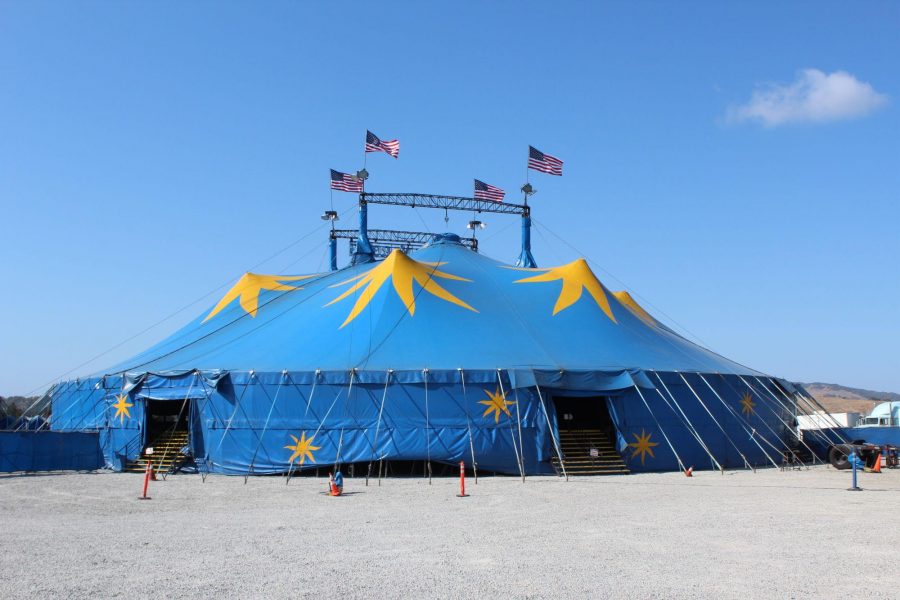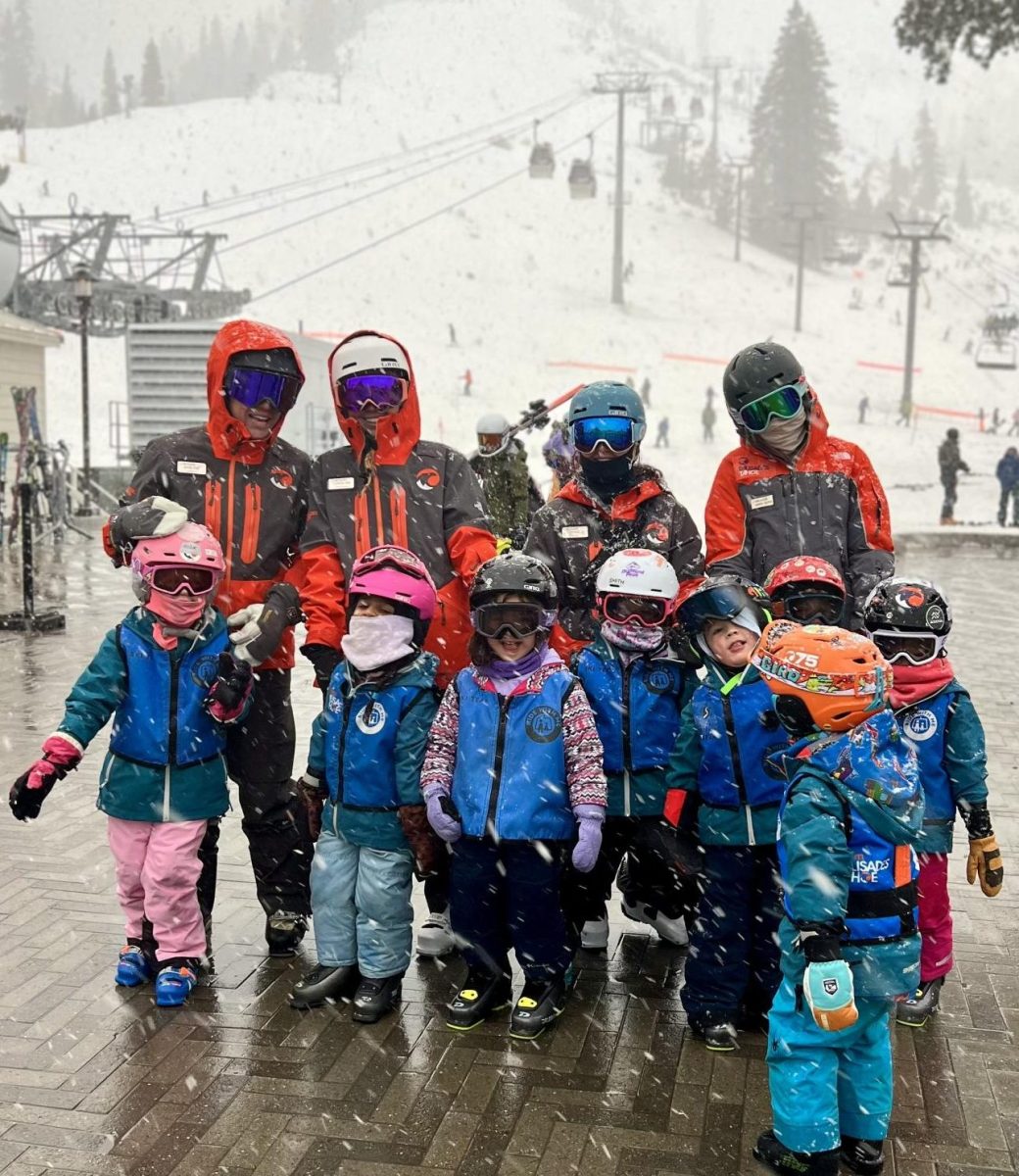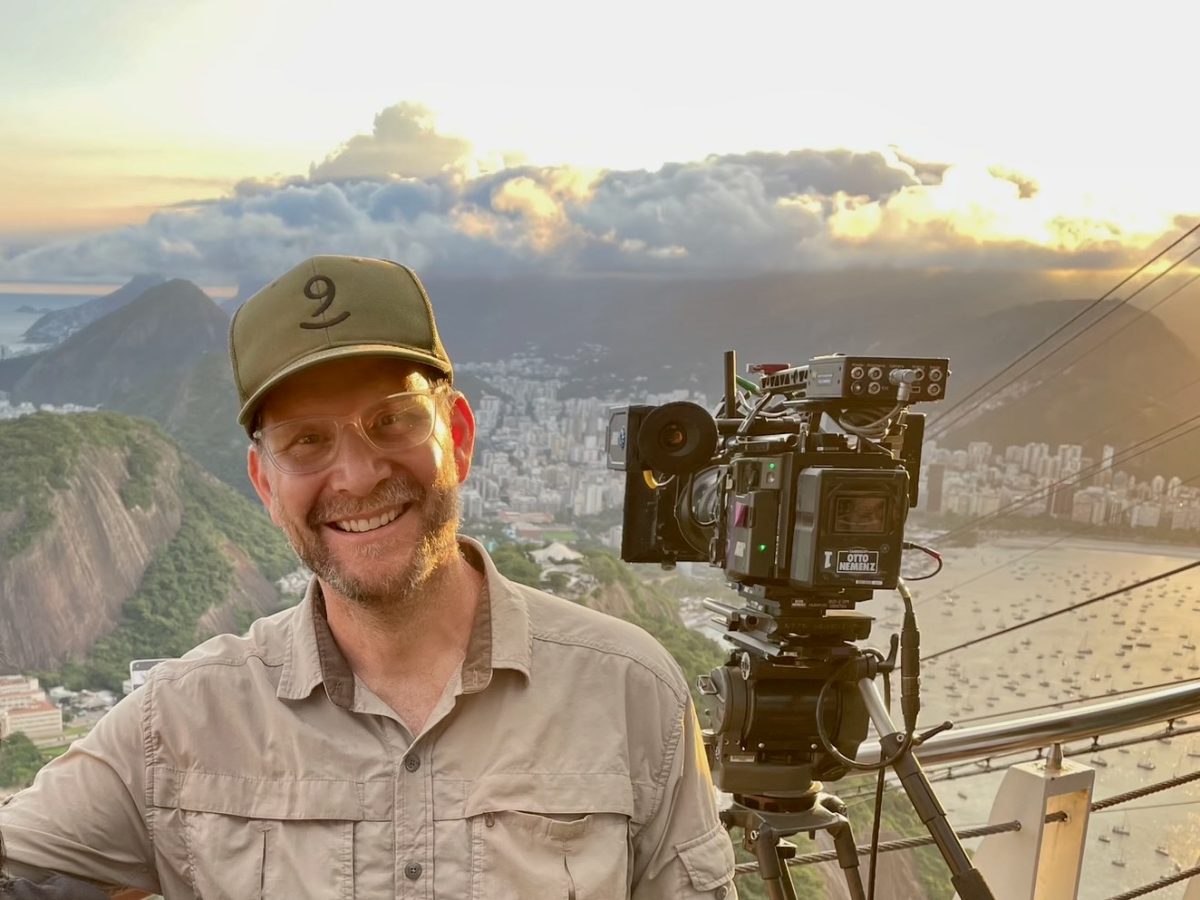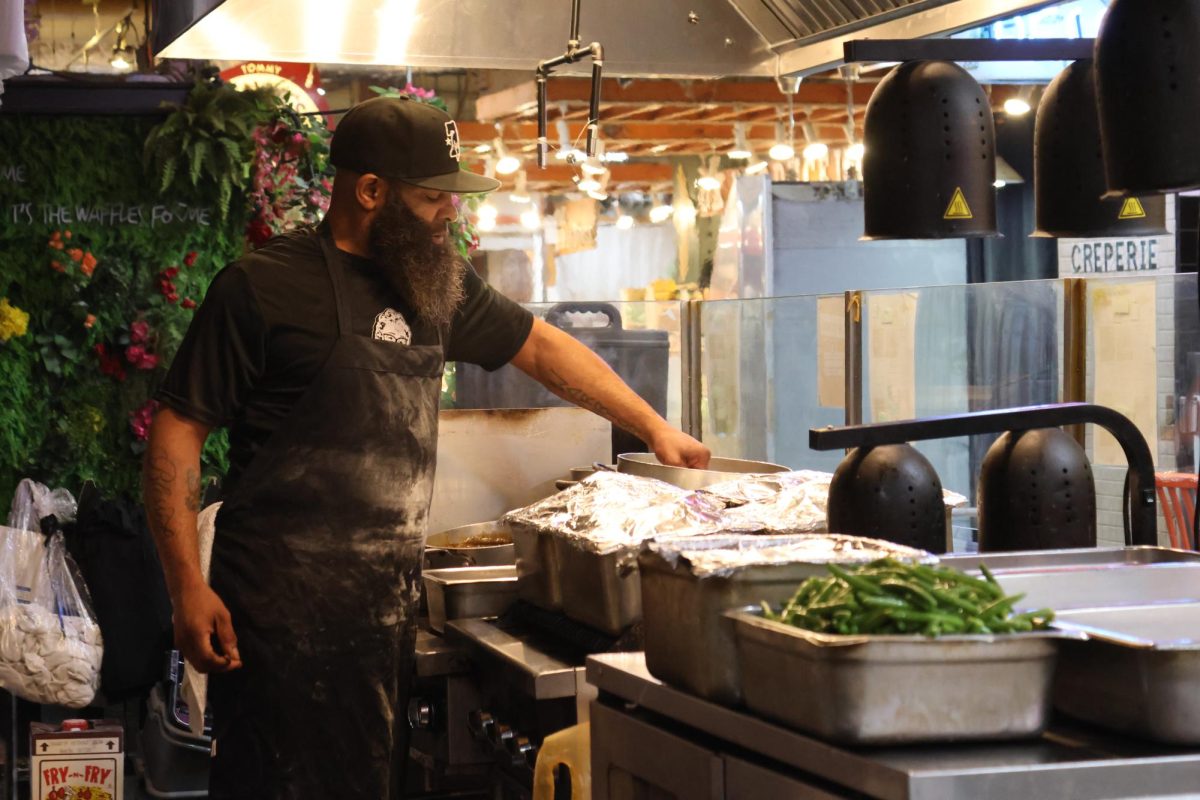
By Eric Ahern and Henry Tantum
As the September sun sinks behind Mount Tamalpais, the last golden rays of summer illuminate the blue structure standing tall in the usually desolate gravel lot across the street from The Village at Corte Madera shopping mall. Four wind-whipped American flags hang atop the canvas edifice as young families, elderly couples and teenagers eagerly make their way through a swinging silver gate, bypassing two bright blue eyes painted on the side of the ticket booth.
Less than an hour later, laughs, screams, cheers and applause spill out into the night sky from within the tent. Audience members look on in awe and disbelief as the members of Circus Vargas risk their lives to entertain.
A man in a neon suit flies 20 feet in the air. A figure stands in a circular cage, while motorcycles whiz just inches past her face. Three young women arch their backs and bend their bodies into incredible formations. Booming music echoes off the canvas walls as green lasers shoot down into the stands.
However, the most interesting piece of the Vargas puzzle is the dynamic between the performers, crew and administration of the circus, who travel, live and work together ten months out of every year.
Some people might call their family a “circus” in a joking manner. But this circus, in all seriousness, is a family.

“There’s nothing I won’t do for this circus.”
Richard “Bumpy” Padilla Jr. has been on the road with Circus Vargas since the early 1990s, taking a brief break only in the early 2000s to work as a correctional officer for San Quentin Prison. Bumpy may not be able to walk on wire, escape from a straightjacket or perform impressive illusions, but he’s treated with just as much respect as anyone else who works for and travels with Vargas.
“I’m a jack of all trades,” Bumpy said. “Right now I’m doing parking, because the young guys can’t park cars. I do a lot of stuff here. I love it here. I’m like family to them.”
Along with family comes loyalty and Bumpy considers himself to be the epitome of a loyal employee.
“There’s nothing I wouldn’t do for the people here… I work all day long, I get paid well, I fix things, I make things,” he said. “There’s nothing I won’t do for this circus. If they ask me anything, I say ‘okay, no problem.’”
Almost 25 years ago, Bumpy came across a “Help Wanted” sign for Vargas and promptly got an interview.
“There’s this little Italian guy yelling and screaming,” Bumpy said, referring to the former owner of Vargas, Vittorio Arata. https://vimeo.com/183892402
“What the hell do you want!?” Arata then shouted, according to Bumpy.
“I said, ‘do you have an opening?’ He grabbed my arm and said ‘tent crew!’” Bumpy said.
Bumpy’s first few weeks in the circus were demanding, but he soon felt at home. Since then, over many eventful years with Vargas, Bumpy has attempted to stay with the circus as much as he physically can.
He once spent a week in the hospital to treat high blood pressure, and after being released was welcomed back with newfound respect from the employees who had to complete his tasks while he was away.
“When I was gone, they realized how much I do,” Bumpy said. “I don’t look at [the work] that way. Every day is a new adventure. Every day I start in the morning and keep on working until the night. I love it.”
Bumpy has invested years of his life in Vargas and credits this fierce loyalty to how well he has been treated by the company.
“In other circuses they think that we’re workers, and we’re not like them. But here, in this circus, performers are performers, but the workers are, too. We work together, we live together, we eat together, do everything together like a family. No separation,” Bumpy said.
These aspects of the circus life have left Bumpy with feelings of satisfaction and gratefulness.
“[The circus] keeps me young; it does keep my children on my back all the time. My sons keep asking me when I’m gonna leave the circus and get a real job,” Bumpy said, with a chuckle.
“For us, our home is the circus.”
From the moment she was born, the stunning and calculated Katya Arata Quiroga was a (unofficial) circus member like both her parents before her. Growing up in Austria, Katya studied classical ballet and entered the circus industry officially at the age of 16. In 1989, she met her future husband, Nelson Quiroga, at Circus Vargas, where they performed for three years before getting jobs with other circuses around the world. Then, five years ago, the couple was given the opportunity to purchase Circus Vargas, and chose to take it. Katya, a seventh-generation circus performer, now holds the position of vice-president of the entire operation. From childhood to adulthood, the circus has surrounded the lives of Katya and her family, and the lives of many other performers.
“Most of the people who are performing are multigenerational, they’ve done circus, their parents did circus, their parents’ parents did circus,” Katya said.[vimeo id=”https://vimeo.com/183892347″ size=”large” align=”right”]
Katya and her husband employ and live with an estimated 65 circus workers and performers. The ragtag team of Vargas consists of grandparents and children, clowns and acrobats, a school teacher; a variety of characters that have intertwined themselves into the community. Katya does not see the group as many separate entities, but as one family, living and working together towards a final product.
“It’s a wonderful thing, not just to make other people happy but to have the opportunity to work with my entire family all together,” Katya said.
For Katya and her family, home is not tied to any one location. Instead, the towering blue tent, rows of recreational vehicles, countless heavy duty trucks for transporting equipment and people and the circular stage which travels up and down the West Coast serve as their hometown.
“It’s a little city that travels without a zip code,” Katya said. “The only thing we’re lacking is a post office…for us, our home is the circus.”
“The performers become like family.”
Although there are a number of infants and small children travelling with Vargas, Daniella Quiroga and Max Weiss are currently the two youngest members of the circus actually performing in the show, aged 14 and 16, respectively. Daniella is the daughter of Vargas owners and operators, Katya and Nelson Quiroga, and Max’s entire family also travels with and performs in Vargas.
The two teenagers act and dance in the opening and closing performances of the show. The two skits revolve around the mockery of modern technology use and the neglect of true beauty and fantasy. Daniella and Max only started performing within the last few years, but both have been in the circus industry for their entire lives.
“We were born into it,” Daniella said. “It’s really fun, you get to do what you love every day. It’s probably the best…thing.”
“The best thing?,” Max asked Daniella with a joking smile.
“The best thing,” Daniella reaffirmed.
The two teenagers were quick to point out the benefits of living in and working for a traveling circus.
“Traveling is one of the perks of being in the circus,” Max said. “You get to see so many places and so many people. You have friends all over.”
In addition to forming relationships nationwide, Daniella and Max have also had the opportunity to bond with the other members of Vargas.
“The performers, they become like family in a sense,” Daniella said. “You see them every day. It’s like one big family, a whole community. It definitely [improves] the performance.”
Along with the positive feelings that come with being behind the scenes, both Max and Daniella love the surge of emotion that comes from performing in Vargas.
“You feel so much joy, it’s a wonderful feeling. It’s hard to explain,” Max said.
Their unique living situation doesn’t afford the teenagers the opportunity or time to receive a traditional education. However, according to her children, Katya Arata Quiroga highly values education, so arrangements were made for kids traveling with Vargas to learn on the road.
Max and Daniella are satisfied with the lifestyle they inherited, admit that it presents its own set of challenges. Max sells popcorn in the stands after his act is completed. Daniella hesitantly referred to the downsides of having grown up in a circus and never really having a permanent home.
“It can be difficult at times, if you make friends in certain places and then you have to leave in a couple of weeks,” Daniella said.
“No one else has [left the circus] in our family.”
Annabel Bachliyski, Mariella Quiroga, and Nicole Weiss stand close to each other in a line, smiling as they reflect upon their performance earlier that night. The teenagers specialize in contortionism and strength acts, feats nearly impossible to master. Luckily for them, they have had plenty of time to do so.
Each girl is 18 years old and was born into the business, but none were given much choice as to whether the circus life was for them.[vimeo id=”https://vimeo.com/183892001″ size=”large”]
“You have to choose something you love to do in the show,” said Mariella, an eighth generation circus performer.
“And if you don’t love it, you just do it anyway. We kind of just got thrown into this life, but we’ve learned to “love” it,” Nicole replied, making air quotes around the word love.
Bachliyski said that the girls feel an obligation to follow in their family’s footsteps.
“It’s not technically [that we are] pressured into doing circus, but [we are] scared to leave or to move outside of the circus because no one else has done it in our family,” she said.
All three girls hope to attend college somewhere in California next year, but say that they will likely re-join the circus after they graduate. However, none of them have much experience with life outside the industry and have never received a traditional education.
“[The circus] is not really a job, it’s more of a lifestyle,” said Nicole. “If you’re not used to this lifestyle, it’s going to be a really different experience.”
According to the girls, some people immediately draw conclusions about the typical circus performer without even knowing them outside of the ring. However, all three girls disregard the negative connotation that is associated with being a part of a traveling circus.
“Some people don’t think that circus people aren’t normal people, but we really are. We do everything that everyone else does,” Bachliyski said.
“Basically, we’re just like you but with a different job,” Nicole added.


















